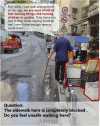"I Go Outdoors for Activities Every Day": Go-Along With Seniors With Slow Walking Speeds to Explore Environmental Factors Influencing Mobility
- PMID: 38895106
- PMCID: PMC11182988
- DOI: 10.3389/ijph.2024.1607033
"I Go Outdoors for Activities Every Day": Go-Along With Seniors With Slow Walking Speeds to Explore Environmental Factors Influencing Mobility
Abstract
Objectives: This study aims to: 1) Explore the mobility experiences of seniors with slow walking speeds (SSWS) in urban neighborhoods; and 2) Investigate their environmental barriers and supports.
Methods: Go-along interviews were conducted with 36 SSWS residing in urban neighborhoods of Chongqing City, China. The mobility patterns and built environment factors influencing their mobility were revealed through cartographic analysis and thematic analysis.
Results: SSWS primarily focused their activities within a 400-meter radius of their homes. Built environment themes included topography, neighborhood services, sidewalks, seating, traffic safety, weather, greenery, and lighting. Significant mobility barriers included long stairs, steep slopes, fast-moving objects on sidewalks, road crossings, and fast traffic. Available handrails, nearby food-service places, ample seating, and greenery were identified as supportive factors for their mobility.
Conclusion: This study stands out as the first to specifically examine the mobility of SSWS within the built environment. We suggest that SSWS should be taken into account when establishing a benchmark for general design frameworks. These improvements not only contribute to the mobility of slow walkers but also have positive impacts on the broader population.
Keywords: go-along interview; mobility; seniors; slow walking speed; walking barriers.
Copyright © 2024 Mou, Qin and Niu.
Conflict of interest statement
The authors declare that they do not have any conflicts of interest.
Figures




Similar articles
-
Differences in perceived neighborhood environmental supports and barriers for walking between US adults with and without a disability.Prev Med. 2020 May;134:106065. doi: 10.1016/j.ypmed.2020.106065. Epub 2020 Mar 16. Prev Med. 2020. PMID: 32194096 Free PMC article.
-
Outdoor built environment barriers and facilitators to activity among midlife and older adults with mobility disabilities.Gerontologist. 2013 Apr;53(2):268-79. doi: 10.1093/geront/gns119. Epub 2012 Sep 25. Gerontologist. 2013. PMID: 23010096 Free PMC article.
-
The role of environmental factors for the onset of restricted mobility outside the home among older adults with osteoarthritis: a prospective cohort study.BMJ Open. 2017 Jun 30;7(6):e012826. doi: 10.1136/bmjopen-2016-012826. BMJ Open. 2017. PMID: 28667194 Free PMC article.
-
Exploring associations between physical activity and perceived and objective measures of the built environment.J Urban Health. 2007 Mar;84(2):162-84. doi: 10.1007/s11524-006-9136-4. J Urban Health. 2007. PMID: 17273926 Free PMC article.
-
Experiencing Public Spaces in Southern Chile: Analysing the Effects of the Built Environment on Walking Perceptions.Int J Environ Res Public Health. 2022 Oct 1;19(19):12577. doi: 10.3390/ijerph191912577. Int J Environ Res Public Health. 2022. PMID: 36231877 Free PMC article.
Cited by
-
Distance from home and working memory: daily associations varying by neighborhood environments in community-dwelling older adults.Eur J Ageing. 2025 Apr 5;22(1):17. doi: 10.1007/s10433-025-00841-5. Eur J Ageing. 2025. PMID: 40186720 Free PMC article.
References
-
- WHO. National Programmes for Age-Friendly Cities and Communities: A Guide. Geneva, Switzerland: WHO; (2023).
-
- Biglieri S, Dean J. Fostering Mobility for People Living with Dementia in Suburban Neighborhoods through Land Use, Urban Design and Wayfinding. J Plann Edu Res (2022):0739456X2211137. 10.1177/0739456X221113796 - DOI
MeSH terms
LinkOut - more resources
Full Text Sources

